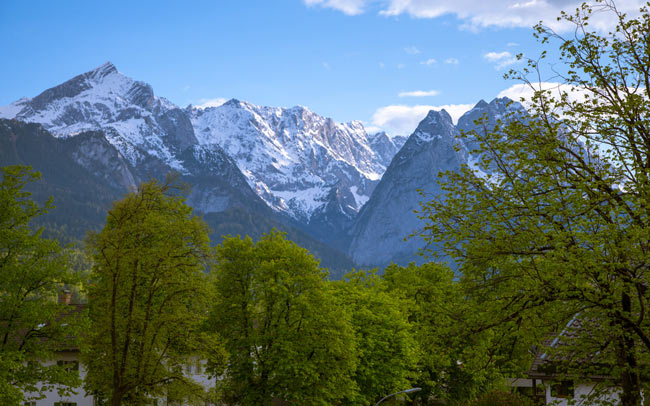

My family took a lot of road trips when I was little. Mom would hold the map, directing dad when he got lost, while my siblings and I played games in the back seat. The family car allowed us to explore the mountains and countryside, visiting locales well off the beaten path.
As an adult, I’ve always loved small towns and rural landscapes — places you need a car to reach. But when it came to traveling in Europe, I usually stuck to places I could reach by public transportation. To be honest, the thought of driving in a foreign country intimidated me.
Thanks to GPS technology, all that has changed. When my fiancé, Benjamin, and I headed to Germany this time, we rented a car with GPS, set its language to English and off we went.
The German road system is excellent, with clearly marked signs and well-maintained streets, and with the GPS as our guide, navigating was easy. Within an hour, we’d left the Munich Airport behind and were in the heart of the German Alps near Garmisch-Partenkirchen.
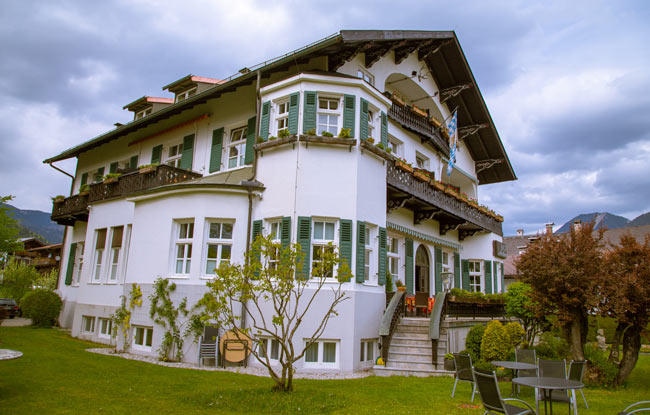
Garmisch-Partenkirchen: Alpine Delight
With an envious location at the foot of the Zugspitze, Germany’s tallest mountain, Garmisch-Partenkirchen is one of the country’s top alpine destinations. As you can imagine, this small town of 28,000 is a busy place during the winter, when skiing, snow shoeing and other winter sports bring in travelers.
I’m happy, though, to be here in the summer months. Colorful flowers bloom in window boxes along the cobblestone streets, and the outside patios of local restaurants are filled with diners. The Alps, now a dark green, provide a dramatic backdrop against a bright blue sky, creating a tempting atmosphere for exploring.
We make our base at the Hotel Aschenbrenner, a mansion built by the Princes of Reuss that has been lovingly restored as a 23-room hotel. Then we head to the hills – literally.

We choose the Eckbauerbahn as our mode of transportation. The nostalgic two-seater gondola carries guests to the top of Eckbauer Mountain. The twist is that you can have breakfast on your way up. As soon as we board, the lift attendant places a wooden tray between us filled with white sausages, thick pretzels and tasty mustard. To drink, Benjamin chooses a beer (for breakfast?!) and I have juice. But the best part of our experience is the amazing view of the Alps as we ride to the top.
At the peak, we follow a series of well-marked trails through alpine meadows, passing a herd of goats with bells around their necks ringing merrily. From there, we hike down to Partnach-Gorge. In the past, hiking the gorge was dangerous, but today, a well-developed path takes you along the gorge and even through tunnels that have been blasted through the rock.
Water drips on us as we follow others through tunnels along the river. We pass a small statue of the Virgin Mary tucked in a careful niche, a reminder of Bavaria’s Catholic heritage.
We’re famished after our half-day hike, and spend the afternoon at the historic Ludwigstrasse, a cobblestone street lined with traditional German restaurants and small shops. A sweet smell leads me to Chocolaterie Amélie, where I find some unusual items made of chocolate. I choose a realistic-looking hammer and wrench (all chocolate, of course) for my son, and we head to our hotel for the evening.
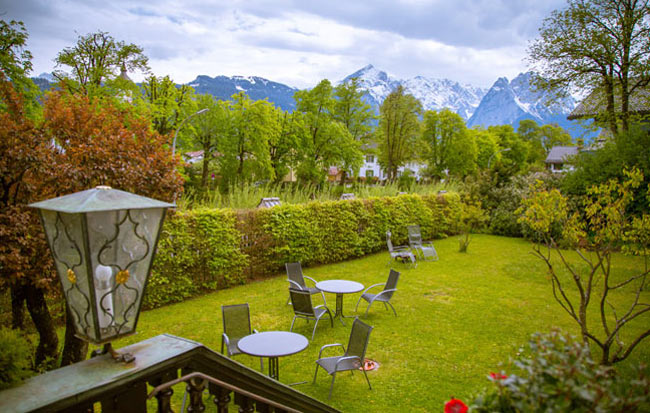
It’s early when we wake the next morning, and the first thing I see out my open window are the snow-covered peaks of the German Alps painted broadly against a summer sky. The sound of the nearby rushing river mixes with a cacophony of birds, celebrating the coming of day. I lay in my bed, soaking it all in. Soon though, I get up, eager to see what the day will bring.
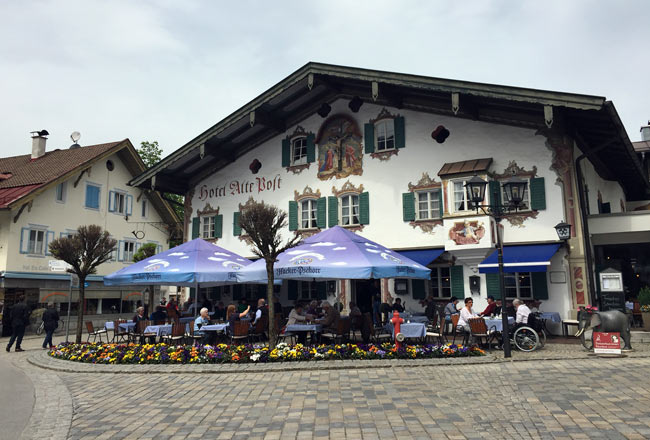
Oberammergau: Small Town with a Passion
Not far from Garmisch-Partenkirchen, we drive to the village of Oberammergau. This little town keeps its promises. In 1634, bubonic plague swept through the village. The inhabitants promised God that they would perform a passion play every 10 years if they were spared. After that, not one citizen died of the plague – and they have been performing the play every decade since then. (The play takes place on years ending with 0.) Oberammergau is small, yet half of the town takes part in the play – some 2,000 people.
Unfortunately, we’re not here during play time, but we still enjoy the town. Oberammergau has a scenic alpine setting, and its narrow streets are lined with homes painted with Lüftlmalerei (wall frescoes that tell a story). The town is famous for its woodcarving, and has almost 50 woodcarving shops today. I find a hand-carved Christmas ornament for our family tree. It will be a tiny, but strong remembrance of our time here.
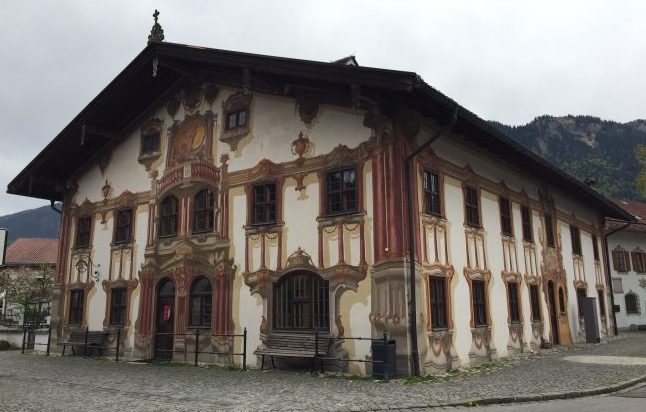
Oberammergau is a walkable town, but all this exploring can make a person hungry. We stop at one of the many outdoor beer gardens in town for a huge schnitzel and a beer. I’m not a huge beer drinker, but in Germany, it only seems right to sample the local fare. I’ve come to like Radlers, a German drink which is made of half beer and half Sprite. In the heat of a summer day, these really hit the spot.
Beer isn’t the only thing I like in Germany. Later we tour the basilica at Ettal Monastery, and then stop by the monastery’s Schaukäserei (show cheese factory). Not only do we get to watch how cheese is made, but we sample four different varieties of cheese. Delicious!
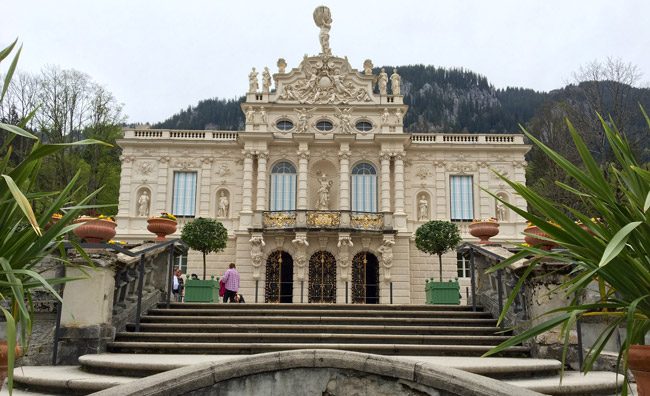
Aristocratic Heritage in Germany
Germany’s royal heritage runs deep, and no visit to the country would be complete without a stop at a palace or castle. In the beautiful Ammergauer Alps region near the town of Ettal, we stop at Linderhof Palace, a summer place built by King Ludwig II of Bavaria in 1878. We spend the afternoon exploring the palace, where we take an informative tour led by a guide with a fun sense of humor, and then hike up into the gardens. We even take a tour of the palace Grotto. The King built an artificial stalactite cave where Richard Wagner’s operas were performed just for him.
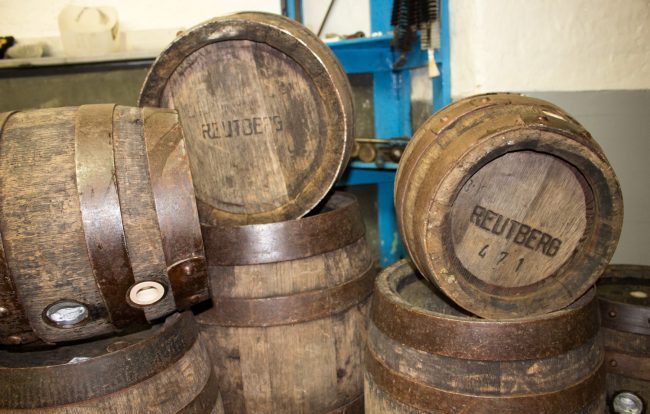
Bad Tölz/Reutberg: German Beer Tradition
Bavaria is known for its beer, which is brewed in accordance to purity law tradition established in 1516. That love of beer permeates the culture, so we’ve planned a visit to two different breweries.
From Garmish-Partenkirchen, we take a leisurely one-hour drive to the Reutberg Monastery, which is known for its beer making. The monastery is located in the small town of Sachsenkam and is surrounded by farmland. At its large outdoor beer garden called Klosterbräustüberl, we watch cattle grazing in the flower-filled pasture with gentle mountains rising in the background. German beer gardens are relaxed and casual. You don’t need a reservation, and you’ll often find families there with children.
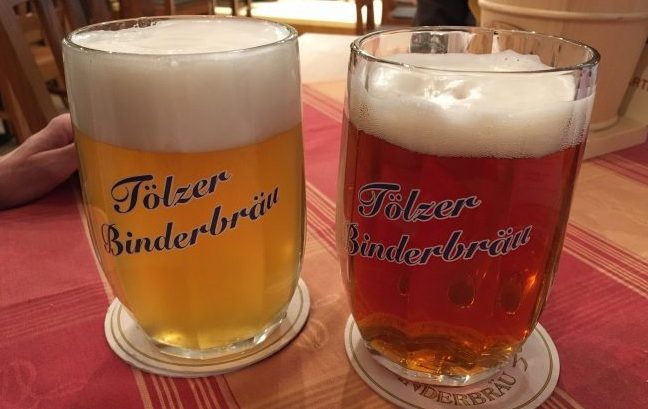
From the historic monastery, we head the car to Bad Tölz to experience the modern side of beer making in Germany. We stop at the Tölzer Brewery, where Andreas Binder and Andreas Forstner make innovative craft beers that have found a strong following. They give us a tour of the small brewery, and then we get to sample some of their creation. Benjamin’s favorite is the Braun Bier, an amber beer the brewery is trying out, and I have another Radler, this time with a dark craft beer as the base.
The Bad Tölz region is a popular destination for Germans who seek a place to unwind in a healthy, natural environment. We see that commitment to nature at Kräuterpark Bad Heilbrunn, a community herb garden and learning center in Bad Heilbrunn. One of the garden experts takes us on a tour of the gardens, introducing us to several new herbs. She shares how they can be used for taste and to enhance a healthy lifestyle. I hadn’t known that dandelion leaves could be used in cooking, but we taste them, and they’re not bad.
Altmühl Valley: Nature in Bavaria
There are detours on our next leg of the trip, and our two-hour drive becomes four. But we don’t mind, because it takes us along yellow canola fields in bloom, and past tidy farmhouses and rural villages. Eventually, we end up at the Altmühltal Nature Park, a German treasure that is little known by American travelers.
Just an hour from Munich, the Altmühltal Nature Park is a protected area of 3,000 sq km, and it’s ideal for those who want an active vacation. An extensive trail system provides opportunities for hiking, cycling, canoeing and more. Benjamin and I hike part of the Altmühl Valley Panorama Trail, a 200 km path that was voted Germany’s favorite walking route in 2012.
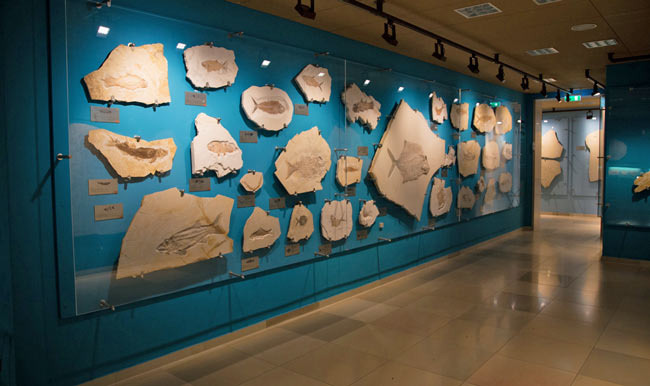
Afterwards, we drive to the nearby town of Solnhofen. The Altmühl Valley region was once at the bottom of an inland sea, and is rich in fossils. The small, but very well-done Museum Solnhofen houses an incredible collection of fossils that have been found in the nearby quarries.
My favorite part of visiting this beautiful valley, though, is seeing several of its small towns. Built on rural heritage, the region is rich in farmland and is famous for its sheep. We get to sample a traditional lamb dish that evening at Zur Sonne Restaurant in the tiny village of Papenheim (population 1,500).
Papenheim is also home to one of Germany’s smallest microbreweries. Papenheimer Beer is made by a talented brew master in his garage. We like the beer and its story, so we get several bottles to take home to the US. (Editor’s Note: At publication, these bottles have made it back home safely, and are being enjoyed by the Go World team.)
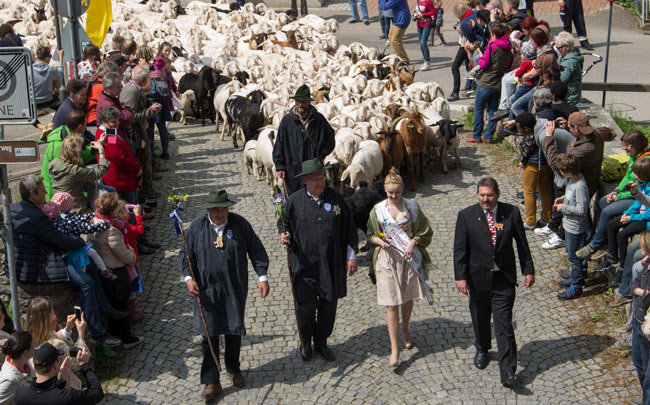
The most unusual view of the region’s sheep comes the next day when the town of Mörnsheim holds a festival celebrating the taking of its sheep into the hills for summer grazing. As part of the festival, more than 1,000 lambs and sheep are herded through the town’s cobblestone streets and then up into the hills, guided by shepherds and their sheep dogs.
Waiting for the sheep to make their appearance, we listen to a folk band play and line up with the locals for tasty lamb sandwiches and the ever-present beer. Children jump up and down in anticipation, and I hear laughter from many corners of the town square. Finally, we hear the sound of bells and the whistle of the shepherds to their dogs. Then hundreds of sheep flow past in a wriggling wave, their bells ringing and small feet clambering loudly on the cobblestone.

When the sheep have gone, we stop at a nearby stand for poppy seed strudel and coffee. Suddenly a quick rain storm appears. Everyone grabs their pastries and we run to a nearby tent with picnic tables. We crowd together – local residents, the festival’s “Lamb Queen”, members of the German folk band, the mayor, and two Americans who are happy to have landed here.
As the rain pours down, the jovial group jokes around, sometimes in English (for our sakes), sometimes in German. It’s a contented moment that sums up our time here in Germany. We’ve had the chance to see many small communities, places not built for tourists, but for everyday lives. And for just a short time, we’ve become not tourists, but travelers, giving some of ourselves, and taking a little bit of this place with us when we return.
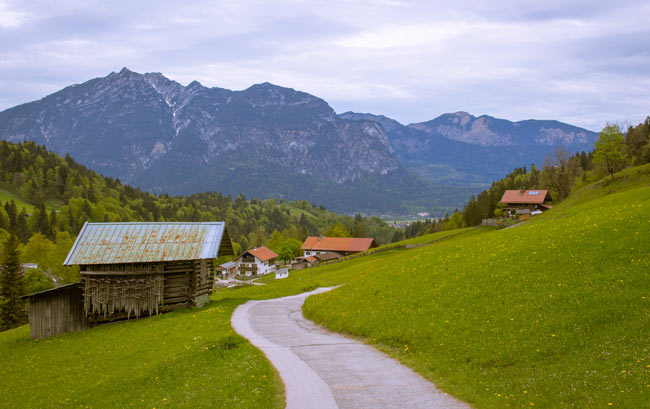
Getting to Bavaria
Most travelers enter Bavaria through Munich. Trains and buses connect Munich to most major European cities, and there are many international flights to Munich’s modern airport. (I took a non-stop from Denver to Munich with Lufthansa.) Munich is home to Airbräu, the world’s only airport brewery, so you might want stop for a bite to eat and a traditional German beer before you head out. (It seems a fitting way to start a German travel adventure, don’t you think?)
Renting a Car in Bavaria
You can rent with most major car carriers, and most have locations at or near the Munich Airport. Be sure to reserve a GPS. Most rental cars in Germany are manual, but you can request an automatic.
Language
Most Germans speak some English, and many speak it very well. I’ve always found them to be welcoming and helpful, often with a fun sense of humor. It’s customary to say hello and goodbye to the shopkeeper or restaurant staff when you come into and leave a place of business. Don’t be afraid to smile and ask for help if you need it, and a heartfelt Danke (thank you) always goes a long way.
Expert Insight
Locals are always the best source of travel information. The German Tourism Office has a comprehensive site with tips, places to stay, what to do, etc, at Germany.Travel For information on travel in Bavaria, see bavaria.us.
Staying Connected
If you’d like to stay connected via phone and internet, consider getting a European SIM card to use in your phone. As long as your phone is unlocked, you can simply change the SIM card and use your phone with that. I used a SIM card from HolidayPhone.com. SIM card plans start at $50, and they will ship the card to you before the trip.
Author Bio: Janna Graber has covered travel in more than 40 countries. She is the editor of three travel anthologies, including A Pink Suitcase: 22 Tales of Women’s Travel, and is the managing editor of Go World Travel Magazine.
- 6 Reasons to Visit Portland, Maine (+ Travel Tips) - April 18, 2024
- Cruising with Discovery Princess on the Mexican Riviera - March 30, 2024
- La Paz, Mexico: Pearl on the Sea of Cortez - February 26, 2024
